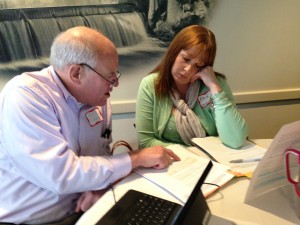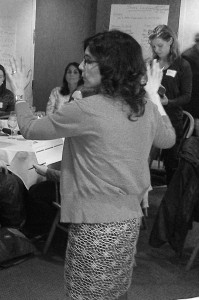ALBA inspires Massachusetts teachers
When do you stand up for what you believe in? How do pictures and posters work to shape the public’s perception of historical events? Why did Franklin Roosevelt feel that his hands were tied by the Catholic vote so that he couldn’t intervene in the Spanish Civil War? And how in the world do you explain to your mother that you have gone to Spain to fight fascism? These are the questions that Massachusetts high school students will be grappling with in the years to come as they work with the primary sources from the ALBA collection at NYU’s Tamiment Library.
Last March, thirty social studies teachers from several western Massachusetts schools gathered on the campus of Mount Holyoke College in South Hadley for a productive six-hour workshop led by ALBA’s Peter N. Carroll and Sebastiaan Faber together with master teacher Kelley Brown and Richard Cairn, Director of the Emerging America and Library of Congress Teaching with Primary Sources Program at the Collaborative for Educational Services of Northampton, MA.
During the morning session, Carroll showed how the Spanish Civil War and the Lincoln Brigade provide compelling windows into a range of major threads in United States and world history, from the Great Depression and the New Deal to isolationism, the Cold War, McCarthyism, the civil rights movement and the defense of human rights. Faber, who teaches at Oberlin College, illustrated how the visual archive of the Spanish Civil War—particularly photographs and posters—can be used fruitfully in a high school setting. “Students are more visually literate than any previous generation,” he said; “they are very good at reading and thinking about images, because they produce and manipulate images all the time.”
The participating teachers received a copy of the documentary The Good Fight, which they viewed in advance of the workshop, a 75-page binder with Lincoln Brigade letters, speeches and testimonies, lesson plan templates and other resources as well as access to ALBA’s new teaching resource website.
Under Rich Cairn’s and Kelley Brown’s expert guidance, the afternoon session allowed teachers to design lesson plans that use ALBA’s compelling primary-source materials to meet Common Core State Standards. Brown led the teachers through a gradual process that allows students to complete a complex task in a series of distinct steps. “The Common Core Standards set clear benchmarks for your students,” she said, “but they don’t tell you how to get there. For example, students are expected to formulate a research statement and find evidence in primary sources to back it up. That’s a daunting task for anyone. But when you properly scaffold your assignments it can be done.”
The participating teachers left inspired and energized. “Tremendous presenters and organization,” one of them wrote, “Any and all materials are prized for future use.” “Powerful subject matter,” another one said. “A wonderful way to spend a Saturday! And I mean it!” Other comments included: “Thank you so much for changing the way history is taught”; “I will be teaching this next year”; “I can’t wait to use the materials with my class!”
The ALBA Institute was made possible with the generous support of the Puffin Foundation, ALBA donors, the Library of Congress Teaching with Primary Sources Program, and the Collaborative for Educational Services.















